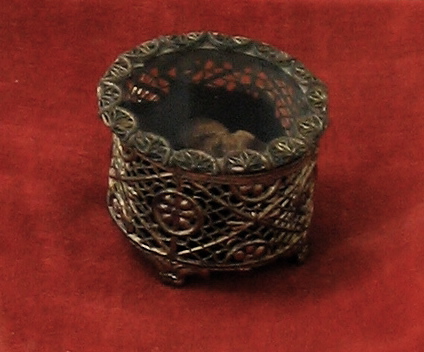
The Significance of a Whitefieldian Reliquary

George Whitefield's Thumb
at the Methodist Archives Center,
Drew University, Madison, N.J.
The recollection of Rev. Samuel Spring, chaplain to the troops of Benedict Arnold in his 1775 march to Quebec, as recorded in J. T. Headley, The Chaplains and Clergy of the Revolution, (New York: Scribner, 1864), 92-93:
There sat the fearless Arnold, the bold rifleman, Morgan, and a host of other brave men, who, notwithstanding their dauntless courage, felt that the perils of the untrodden, mysterious wilderness, they were about to penetrate, might be too great for human energy and endurance, and the hour come, that their only hope would rest in the God whose spirit the chaplain [Samuel Spring] invoked as their guide and stay. The citizens, who crowded the gallery, never forgot that sermon. It became the talk of the place, and was the cause of his eventually settling over them as their pastor. In speaking of the circumstance afterwards Mr. Spring said, "I preached over the grave of Whitfield. After the service the general officers gathered around me. Some one requested a visit to Whitfield's tomb. The sexton was hunted up, the key procured, and we descended to his coffin. It had lain in the tomb six years, but was in good preservation. The officers induced the sexton to take off the lid of the coffin. The body had nearly all returned to dust. Some portions of his grave-clothes remained. His collar and wristbands, in the best preservation, were taken and carefully cut in little pieces, and divided among them." The chaplain, with the haughty Arnold, the chivalrous Morgan, and group of officers, gathered in the dark vault around the tomb of Whitfield, formed a scene worthy of a painter. The clank of steel had a strange sound around the sainted sleeper, while the hallowed atmosphere filled all hearts with solemn awe and reverence.
Analysis from Robert E. Cray,"Memorialization and Enshrinement: George Whitefield and Popular Religious Culture, 1770-1850," Journal of the Early Republic 10, no. 3 (Autumn 1990): 342, 260:
[In the importance placed on Whitefield's tomb] we can observe an aspect of religiosity that transcended dry sermons and formal prayers, official tenets and established dogmas. Evangelical Christians enhanced their faith by means of a pilgrimage to the tomb of the great revivalist, whereby they observed, touched, and handled the remains. A few might even secure relics. Although these Christians attached no miraculous character to the tomb—an essential characteristic of pilgrims to medieval shrines—we do observe a kind of Protestant version of older rituals to saintly individuals. Layfolk and clerics could and did experience their faith by actions and gestures at the tomb. Whitefield's enshrinement reveals how Americans both retained and refashioned elements of earlier practices toward saints, shrines, and relics.
Thomas A. Tweed, "John Wesley Slept Here: American Shrines and American Methodists," Numen, Vol. 47, No. 1 (2000): 53-54.
... because Methodists wanted to distinguish themselves from the Catholic practice of enshrining saints, they did not develop a strong tradition of relic preservation or veneration. One Methodist divinity school exhibits John Wesley's death mask; another preserves George Whitfield's thumb and displays pieces of Wesley's coat. Yet with the possible exception of the World Methodist Building at Lake Junaluska, North Carolina, which one prominent Methodist historian playfully called "the Methodist Disneyland," the United Methodist Church has not encouraged popular reverence for those items or established a pilgrimage center to house them. In this sense, the presuppositions about Methodists, and other Protestants, are correct: they have rejected most kinds of shrines. American Methodists, however, have not eschewed all types of shrines: they have identified and visited commemorative shrines, sites that recall key historical events and transport pilgrims to religiously significant times. And these function as identity shrines since, for many Methodists, collective identity emerges from historical consciousness.
"The piece of Whitefield's thumb is in the lower left-hand corner. Moving upward from it are Francis Asbury's glasses,
a piece of wood taken from Wesley's tree, Asbury's thread case, and a wooden peg from
the First Methodist Church in Rahway, New Jersey. In the center is a piece of rock on which Asbury sat."From Colleenn McDannell, Material Christianity: Religion and Popular Culture in America (New Haven, Conn.: Yale University Press, 1995) 42.